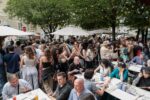Dragoljub Raša Todosijevic – Light and darkness of symbols
Il progetto Light and darkness of symbols di Dragoljub Raša Todosijevic rappresenterà la Serbia alla Biennale di Venezia.
Comunicato stampa
Members of the Professional Council – Irina Subotić (President), Jerko Denegri, Mrđan Bajić, Zoran Todorović and Zoran Erić, have decided that Serbia’s representative on the 54th Venice Biennale of Contemporary Art will be Dragoljub Raša Todosijević with his project Light and Darkness of Symbols. Museum of Contemporary Art Vojvodina will carry out the participation of the selected representative, the exhibition curator is Sanja Kojic Mladenov, while its Commissioner is Zivko Grozdanic.
The title of the 54th International Art Exhibition of La Biennale di Venezia is: ILLUMInations.
La Biennale di Venezia represents one of the most important and influential forums for the dissemination and ''illumination'' of current developments and movements on the international art scene. Therefore, the starting point and the concept of this year's Venice Biennale artistic director, Swiss art historian, critic and curator, Bice Curiger, is a historical reference to the work of Venetian painter Tintoretto, whose occupation with light, either rational or transcendental, can be viewed as significant for the work of many contemporary artists. Accordingly, the National Participations were invited to represent their countries in pavilions through the work of artists dealing with questions related to the central exhibition theme – ILLUMInations.
Through the issue of symbols, the project of the Belgrade conceptual artist Rasa Todosijević is engaged in observation and ''clarification'' of sociopolitical, economic and cultural context of the author’s social environment, with special focus on sensitive issues such as mythology, religion and power. The Project Light and Darkness of Symbols is composed of several segments, conceptualized through the different forms of installations, journal, and history.
At 54th Venice Biennale, Todosijević will present the exhibition in three interdependent parts.
The first part of the exhibition refers to the works under the title ''Journal,'' which represent the sum of 120 smaller works produced in different materials, with different conceptual approaches and in different dimensions. Each individual art piece can be displayed and interpreted as a separate artistic entity. Designed in this way, the ''Journal'' is a constantly supplemented and growing unit with changing variables and relations where each piece is complete and independent. Therefore, these are not drafts, but conceptually compose a larger piece.
The first version of ''Journal'' was exhibited at the Gallery Remont in Belgrade, the second at the retrospective exhibition of Todosijević’s works at the Museum of Contemporary Art in Belgrade, and the third at the retrospective exhibition at the Gallery of Contemporary Art Celje in Slovenia. Furthermore, the fourth was a retrospective exhibition at the National Gallery for Foreign Art in Sofia, the fifth an independent exhibition at the Gallery Ozone in Belgrade, the sixth version was on the 50th October Salon in Belgrade, while the seventh was presented at a recently held exhibition entitled ''Serbia – Frequently Asked Questions'' in the gallery of the Austrian Cultural Forum New York.
The second part of Todosijević’s exhibition at the 54th Venice Biennial will be the work entitled ''Installations''.
The one part of the exhibition 'Installations'' will consist the works borrowed from the existing art collections and pieces which have also been produced before, but in a way that allows further expansion, refinement or extensions – for instance, the piece entitled ''The Sculpture'' which consists of fifty teapots filled with cement. This piece is a part of a series of works in which Todosijević constantly discusses some of the inherited conceptions and understandings of the Art.
The series entitled ''Installations of Grand Piano or Upright Piano'' - keyboards pierced by canes - will also be exhibited at the 54th Venice Biennial. These pieces are subordinated to the idea which, among other things, brings into the question the meaning of the term ''traditional materials''. Stabbed pianos were made of the so-called classic materials, classic instruments and archaic canes, that symbolize age and infirmity, as well as patriarchy, the leader, leadership, power...
The exhibition also includes a series of installations collectively entitled ''Gott liebt die Serben'' (God Loves the Serbs) which, in fact, denote the debate about the constantly changing interpretation of symbols and conditionality of these changes in given historical circumstances.
The third part of the exhibition consists of photographs, representing a kind of historical introduction, preface, or retrospective summary of artist’s arrival to the forms of Installations, Journal, Piano, Sculptures... These are the photographs of those Todosijevićʹs works that represent an imposing support of his artistic work and activities, which, as the artist said himself, helped him create his present and allowed him to be who he is.
Conceptually, these artworks represent mainly recordings of Todosijevićʹs performances from the early seventies, such as Decision as Art, Drinking Water, Was ist Kunt – What is Art?; billboards from the Nineties (Murder, Serboranges, Sewage Flower, The Best Wine in Italy, Art is Dead...) and billboards from the end of the first decade of 21st century (Tomorrow is Monday, Mother for Sale, Despite the Economic Crisis…).
An extensive exhibition catalog will present reproductions of many earlier works of Dragoljub Raša Todosijević and provide detailed provenance and exhibition histories of each work, as well as artist’s biography and professional texts.
Raša Todosijević's selected project will be exhibited in the Pavilion ''Yugoslavia'' from June 4th until November 27th, 2011.



